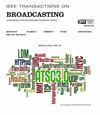非地面网络上的5G多播广播业务:深入的性能分析
IF 4.8
1区 计算机科学
Q2 ENGINEERING, ELECTRICAL & ELECTRONIC
引用次数: 0
摘要
5G多播广播服务(5MBS)在基于第三代合作伙伴计划(3GPP)的非地面网络(NTN)中的集成代表了弥合数字鸿沟和提高多播和广播通信网络效率的重大进步。本文对5MBS在NTN上的集成进行了全面的研究,重点是基于仿真的性能评估。NTN包括地球同步地球轨道(GEO)、中地球轨道(MEO)和低地球轨道(LEO)卫星系统,提供广泛的覆盖能力,特别有利于农村和服务不足地区。一个关键的亮点是结合了基于混合自动重复请求(HARQ)的时间交错(TIL)机制,增强了NTN环境下的广播弹性。NTN信道的特点是高用户移动性和动态信道条件。通过利用时分集和在非连续时隙中扩展编码位,该方法减轻了快衰落和多普勒频移的影响,实现了从低速1db到500 km/h时2.8 dB的性能提升,确保了视线(LoS)和非视线(NLoS)条件下的稳健通信。本研究提出了一种使用链路水平模拟器(LLS)为NTN部署量身定制的5MBS解决方案,考虑了信道建模、环境因素和高移动性场景。结果表明,虽然现有的NTN设置难以在高速环境(例如飞机)中保持性能,但提出的基于harq的TIL在这些具有挑战性的条件下显着提高了性能。这些发现验证了5MBS与NTN集成的可行性,并突出了其提供可扩展和可靠的广播和组播服务的潜力。该研究为5G-Advanced系统的未来增强提供了有价值的见解,并为新型地面网络(TN)-NTN融合部署奠定了基础,为卫星通信网络的发展和国际移动通信(IMT)-2030评估过程做出了贡献。本文章由计算机程序翻译,如有差异,请以英文原文为准。
5G Multicast Broadcast Services Over Non Terrestrial Networks: An In-Depth Performance Analysis
The integration of 5G Multicast Broadcast Services (5MBS) within 3rd Generation Partnership Project (3GPP)-based Non-Terrestrial Networks (NTN) represents a major advancement in bridging the digital divide and improving network efficiency for multicast and broadcast communication. This paper presents a comprehensive study on the integration of 5MBS over NTN, focusing on a simulation-based performance evaluation. NTN, including Geosynchronous Earth Orbit (GEO), Medium Earth Orbit (MEO), and Low Earth Orbit (LEO) satellite systems, offer extensive coverage capabilities, particularly benefiting rural and underserved areas. A key highlight is the incorporation of Hybrid automatic repeat request (HARQ)-based Time Interleaving (TIL) mechanisms, which enhance broadcast resilience in NTN environments. NTN channels are characterized by high user mobility and dynamic channel conditions. By leveraging time diversity and spreading coded bits across non-consecutive slots, the proposed approach mitigates the effects of fast-fading and Doppler shift scenarios, achieving performance gains from 1 dB at lower speeds to 2.8 dB at 500 km/h, ensuring robust communication under Line of Sight (LoS) and Non Line of Sight (NLoS) conditions. This study proposes a 5MBS solution tailored for NTN deployment using a Link Level Simulator (LLS), considering channel modeling, environmental factors, and high mobility scenarios. The results show that while existing NTN setups struggle to maintain performance in high-speed environments (e.g., airplanes), the proposed HARQ-based TIL significantly improves performance under these challenging conditions. These findings validate the feasibility of integrating 5MBS with NTN and highlight its potential to deliver scalable and reliable broadcast and multicast services. The study provides valuable insights for future enhancements in 5G-Advanced systems and lays the foundation for novel Terrestrial Networks (TN)-NTN convergent deployments, contributing to the evolution of satellite-based communication networks and the International Mobile Telecommunications (IMT)-2030 evaluation process.
求助全文
通过发布文献求助,成功后即可免费获取论文全文。
去求助
来源期刊

IEEE Transactions on Broadcasting
工程技术-电信学
CiteScore
9.40
自引率
31.10%
发文量
79
审稿时长
6-12 weeks
期刊介绍:
The Society’s Field of Interest is “Devices, equipment, techniques and systems related to broadcast technology, including the production, distribution, transmission, and propagation aspects.” In addition to this formal FOI statement, which is used to provide guidance to the Publications Committee in the selection of content, the AdCom has further resolved that “broadcast systems includes all aspects of transmission, propagation, and reception.”
 求助内容:
求助内容: 应助结果提醒方式:
应助结果提醒方式:


